Flipping through an illustrated manuscript from the 13th century, you’d be forgiven for thinking that Jesus loved a good fart joke. That’s because the margins of these handmade devotional books were filled with imagery depicting everything from scatological humor to mythical beasts to sexually explicit satire. Though we may still get a kick out of poop jokes, we aren’t used to seeing them visualized in such lurid detail, and certainly not in holy books. But in medieval Europe, before books were mass-produced and reading became a pastime for plebes, these lavish manuscripts were all the rage—if you could afford them. The educated elite hired artisans to craft these exquisitely detailed religious texts surrounded by all manner of illustrated commentary, known today as marginalia.
“Imagination is a much freer thing in the margins of a book; it’s allowed to run amok.”
Kaitlin Manning, an associate at B & L Rootenberg Rare Books and Manuscripts, says part of the reason why modern viewers are so captivated by marginalia is because we expect this era to be conservative when compared to our own society. For example, few Monty Python fans realize that the comedy group’s silly animations are direct references to artwork in illuminated manuscripts. (Illuminated simply means decorated with gold or silver foil.) “I think it’s such a shock when you have this idea in your head of what medieval society was like,” says Manning, “and then you see these bizarre images that make you question your assumptions.” The wild mixture of illustrations challenges our contemporary need to compartmentalize topics like sex, religion, humor, and mythology.
Manning was first drawn to marginalia while studying at the Courtauld Institute in London, where she worked with some of the most significant illuminated-manuscript collections in the world, including those at the British Library. “I loved the idea that marginalia was such an overlooked part of the medieval experience,” says Manning, “so much that up until 20 or 30 years ago, scholars were completely uninterested and wrote it off as trivial or not meaning anything.”
Though the meaning of specific images is still hotly debated, scholars conjecture that marginalia allowed artists to highlight important passages (or insert text that was accidentally left out), to poke fun at the religious establishment, or to make pop-culture references medieval readers could relate to. We’ll probably never understand all the symbolism used in marginalia, but what have we learned about medieval life through these absurd images?
We recently spoke with Manning about the origins and hidden meanings behind this fantastic art form.
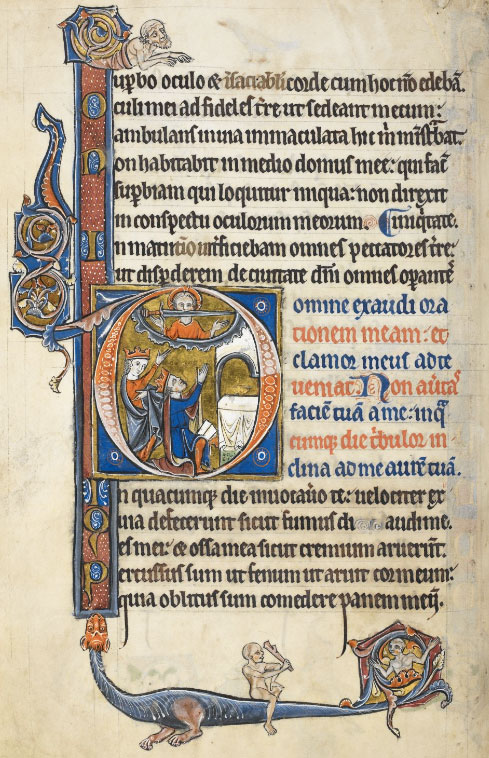
Top: Wild animals at war in the Breviary of Renaud and Marguerite de Bar, Metz ca. 1302-1305. (British Library, Yates Thompson 8, f. 294r.) Above: A typical page from the Rutland Psalter shows a variety of decorative marginalia. (British Library Royal MS 62925, f. 99v.)
Collectors Weekly: How is marginalia defined?
Kaitlin Manning: Generally speaking, marginalia simply means anything written or drawn into the margins of a book. In the medieval context, marginalia is understood to mean images that exist outside or on the edge of a page’s main program. But the term is also sometimes applied to other arts, like architecture. It can describe sculptural details that might seem grotesque or nonsensical to modern eyes. Gargoyles, for instance, could be thought of as a kind of marginalia.
“Marginalia helps us recognize that medieval society was as complex as our own.”
The heyday of marginalia was between the 12th and 14th centuries, more or less. The printing press is said to have been invented in 1450, but that’s just a convenient estimate. Printing wasn’t widespread until the end of that century, and before the use of the press, books were made by hand from start to finish. Traditionally, it was the job of scribes in monasteries who would painstakingly copy and decorate each volume, either for the use of the church or for influential patrons. Although examples of marginalia can be found all over Europe, England and Northern France were particularly productive centers for this kind of art.

Two wild and crazy headless guys in the Summer volume of the Breviary of Renaud and Marguerite de Bar, Metz ca. 1302-1305. (Verdun, Bibliothèque municipale, MS 107, f. 99v.)
The prevailing view for most of the 19th and 20th centuries was that marginalia was nonsensical, unserious, profane, and had nothing to do with the sacred images it surrounded. It was only relatively recently, due to the work of scholars like Michael Camille and Lillian Randall, in particular, that marginalia became viewed as a genre worthy of study in and of itself. Camille has suggested that marginalia emerged from the tradition of the gloss, which is an explanatory note that helps elucidate difficult passages in the text. A gloss wasn’t a footnote; it was actually written into the margin, either in the original language of the book or in the vernacular.
In the context of medieval illuminated manuscripts, the kinds of images that occur in the margins are pretty astonishing. Although there were recurrent themes and symbols, the artists seem to be less constrained by traditional sacred imagery. Think, for example, of how the image of the Crucifixion or the Last Supper became iconic, as the same composition and visual cues were repeated over and over. Imagination is allowed much freer rein in the margins of a book; it’s allowed to run amok. So monsters or human-monster hybrids, animals behaving as humans, and fart jokes were all fair game.

Dragon’s tails and severed legs on the pages of the Rutland Psalter, c. 1260. (British Library Royal MS 62925, f. 98r.)
Collectors Weekly: Were most illuminated manuscripts religious texts?
Manning: Yes, particularly in the 12th century and earlier. The content became more varied as literacy grew more prevalent among various classes and as society became a bit more secularized. Chivalric romances were very popular, as were epic poems and tales of travel (like The Canterbury Tales, for example). Traditionally speaking, however, reading and writing was a concern of the church. Monks and nuns, particularly, needed to be able to read sacred texts, and because their duties included copying them, they needed to write. But in the later Middle Ages, literacy among the secular elite became more common.
“Monsters or human-monster hybrids, animals behaving as humans, and fart jokes were all fair game.”
The Book of Hours was an especially popular type of devotional text in the 14th and 15th centuries and was usually intended for the use of laypeople. It emerged from the tradition of the Psalter, which normally consisted of a book of Psalms plus other types of sacred material to aid the reader in prayer. Psalters and Books of Hours ranged from very modest examples to highly illustrated luxury objects. Of course, the latter are much more fun, and it is within these more expensively made tomes that we see some of the most memorable examples of marginalia. Some marginalia might have been tailored to the tastes of the patron, so it takes on this other level of meaning as well.
Around this same time period, in the 13th and 14th centuries, bookmaking was increasingly in demand, so it started becoming a legitimate profession with artisans, workshops, and guilds. They tended to be concentrated in cities where much of the newer wealth was located. Multiple people worked on creating a book: There was the person who wrote out the text, who may or may not be different from the person who illustrated it, who may or may not be different from the person who illuminated it or painted it and added the gold foils and bound it. Monks were still producing books, but it was shifting to a job for artisans.
Many books from this period are what we would think of as luxury items, which seems weird in the era of e-readers and cheap paperbacks. But these materials were expensive, and coupled with the hours of labor that went into them, books were costly to commission. Many books of hours have donor portraits as well, so the owner literally steps into the book. They become part of that book. It’s worth pointing out that books at that time were very personal objects. Whereas cathedrals were decorated with these biblical scenes and stories for public consumption, reading books was a private experience.
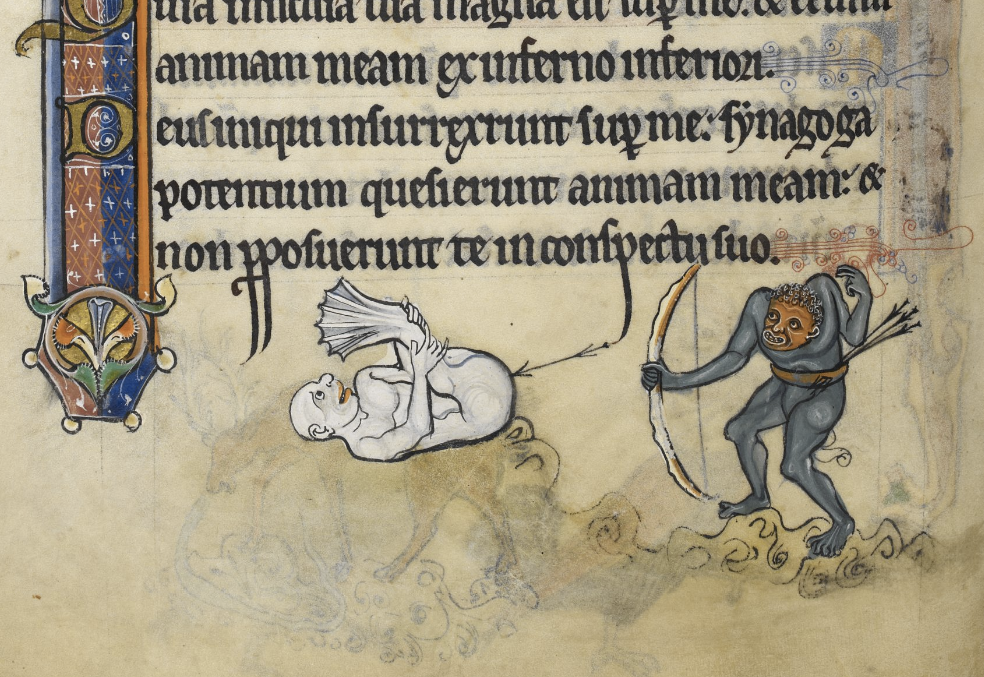
A grotesque image of an ogre shooting an arrow into another creature’s rear from the Rutland Psalter, c. 1260. (British Library Royal MS 62925, f. 87v.)
Collectors Weekly: What was the social standing of artisans at the time?
Manning: The way we think of artisans today is not the way they were viewed in the Middle Ages. Artisans worked with their hands and were therefore on the lower rungs of society. They often worked communally as part of a workshop, and because of that, they rarely signed their works. The result is that marginalia is very difficult to attribute. It’s often hard just to identify the workshop where a manuscript was made.

Killer rabbits existed long before the Monty Python skit, as seen in the Gorleston Psalter, c. 1310-1324. (British Library Royal MS 49622, f. 13v.)
There are a few exceptions where we do know the name of a person who did the manuscript. One name that comes immediately to mind is Matthew Paris. He was a Benedictine monk from the St. Albans monastery during the first part of the 13th century. We have several examples of his work including what’s believed to be a small self-portrait. But this kind of identification is, by far, the exception, not the rule. Like the rest of medieval society, though, there was a hierarchy to the world of artisans, which was often determined by the material with which one worked. Goldsmiths, for example, were at the very top of the pecking order because of the expensive materials they handled.
Michael Camille pointed out in his book that manuscripts were illuminated and illustrated after the text had been laid in. Although it was partly for practical reasons, the order also implies that the status of the image is somehow lower than that of the word. Our modern understanding of the word “marginal” says something about what this sort of art this was. Yet marginalia artists still had the last laugh because they could poke fun at what was already on the page or any mistakes they found.
Collectors Weekly: What types of images are common to marginalia?
Manning: The images vary widely, but they tend to be very strange and even disturbing—overt sexual acts, defecation, monsters, human-monster hybrids, animals acting like humans. There’s also examples of clergy behaving very badly, the sort of thing you would not expect to see in the margins of a sacred book. There are some motifs that do recur, and one that comes to mind is a knight battling a snail. Monkeys often roam the margins, as the monkey was a convenient foil to man, the idea being that they hold up a mirror to our own follies.

A nun plucks penises off a phallus tree in the Roman de la Rose, c. 1325-1353. (Paris, Bibliothèque nationale de France, MS. Fr. 25526, f. 106v.)
I should also mention that not all marginalia is vulgar: It can be helpful by pointing out passages of interest or inserting missing text. It can be a commentary on the text, like a gloss to help you understand the message or illustrate something the text is getting at. I think the rather shocking images are allowed to exist because of the space they occupy. They’re marginal. They’re outside of the conventional picture space. I think boundaries and delineating the known world was really important for medieval society, as much for reasons of survival as for political ambition. What lay outside of these constructed borders was the mysterious unknown. You can see the fear of this idea expressed in world maps at the time, with monsters and freaks inhabiting the unknown spaces.
From a modern perspective, it can be difficult to understand how sacred text and bawdy images could exist side by side, especially given our preconceived notions about the uptight religious fervor of the age. But I think marginalia helps us recognize that medieval society was as complex as our own. While it might be tough for us to grasp the meaning behind such seemingly opposite imagery drawn together on a page, perhaps for the medieval viewer the conflict wasn’t quite so black and white.
Collectors Weekly: What are some of the stranger images you’ve come across?
Manning: One that instantly comes to mind depicts a nun picking severed penises off a tree like fruits, and then placing them in a basket. Another of my favorite motifs within the grotesque or hybrid tradition is a creature with the legs of a human, but its genitals are the mouth of a lion. A hybrid simply means a cross between two or more things, like an ostrich with a human head. A hybrid is a type of grotesque, which is generally understood to mean images that appear distorted or otherwise unnatural. Grotesques are recognizable yet they make you feel uncomfortable, and often lend themselves well to sculpture. You see a lot of grotesques in monasteries and cathedrals.
On the other hand, many of the images in illuminated manuscripts capture mundane, real-life events, like a merchant rolling a cart around or a scribe illuminating a manuscript. Marginalia provides a great repository of information about the way things actually looked, such as clothing, goods, and architecture.

Marginalia also offers a visual record of what ordinary things looked like in the medieval era, like this image of a man working on a forge from the Gorleston Psalter, c. 1310-1324. (British Library Royal MS 49622, f. 193r.)
Collectors Weekly: Why were pictures of excrement so prevalent?
Manning: My sense is that it depends a lot on context, and it could often be commentary about what’s going on in the central text of the page. On the other hand, I also think these low-brow jokes are a nice reminder that medieval society wasn’t just about prayer and plagues. People had a sense of humor and enjoyed a bit of bawdiness, much like today. Some scholars have also pointed out that medieval Europe was a much more sensual society in terms of eating and smells and the more potent aspects of everyday life. Because the senses were so highly engaged, that experience is expressed in art of the time period, including marginalia.
Collectors Weekly: What kinds of references were encoded in marginalia?
Manning: A lot of ink has been spilled in pursuit of marginalia’s coded messages. From what I understand, pop-culture references were often literary or came from the oral tradition, anything that lent itself to a good image. Popular romances like Tristan and Isolde or the Holy Grail show up pretty regularly. I think more common is what might be termed “folk culture” in the form of riddles or pastimes, and most of these references would have depended on the region where the book was made.
To use the example of the knight and the snail, Lillian Randall wrote an article that examined the literary and historical origins of the image. She links the snail to a nickname given to the Lombards, a group disparaged often in the early Middle Ages, among other esoteric connections. While she offers fascinating insight into the meaning of the motif, she also concluded that the image in question could have multiple meanings, and I think that’s really key to understanding what marginalia is all about.

A knight attacks a menacing snail in the margins of the Gorleston Psalter, c. 1310-1324. (British Library Royal MS 49622, f. 193v.)
Animals are a great example of the difference between allusions in the modern versus pre-modern societies. Take the elephant, for example. If you ask anyone today what an elephant means to them, they’ll tell you an elephant never forgets or that they’re afraid of mice. Maybe Dumbo is in there somewhere, or that they’re circus animals. They’re sources of ivory, etc. Those are our modern Western associations with elephants. But go back to medieval sources, and they paint a very different picture.
“These low-brow jokes are a nice reminder that medieval society wasn’t just about prayer and plagues.”
First of all, elephants were often drawn very strangely because almost no one in the West had ever seen an elephant up until the middle of the 13th century. The artist Matthew Paris is often credited with drawing the first anatomically correct elephant after seeing one at the King’s Menagerie in England. In books of the period, elephants were often described as frigid, meaning they didn’t mate with enthusiasm. So this idea of modesty gets wrapped up with ivory, which was seen as a pure, chaste substance suitable for carving religious images. It’s a kind of domino effect of meanings and associations. It was also rumored that elephants lacked knee joints, or that they lived hundreds of years. They were known as the enemies of serpents, and they might represent Adam and Eve in a religious context.
So this example of the elephant illustrates the difficult part about trying to decode these marginal messages—we know some of what they thought, but you can’t trace all the links and wordplays. It makes the job of the art historian that much more difficult because you have to examine possible avenues of meaning from a variety of perspectives.

An early elephant image by Matthew Paris in his Chronica Maiora II, c. 1235-1259. (Parker Library, Corpus Christi College, Cambridge, MS 16, f. 151v.)
Collectors Weekly: Did marginalia subvert the medieval hierarchy or reinforce it?
Manning: I think the answer is both. The medieval world was all about hierarchies, not just in the sense of that three-tiered world that we’re used to hearing about—the church, the aristocracy, and the peasantry. Even within those groups, the divisions and pecking orders were meant to give structure to an otherwise cruel and unordered world.
A phrase that often comes up in studies of marginalia is “Le Monde Renversé” or “the world upended.” And a lot of these marginal images do just that. Some images will include recognizable members of medieval society doing inappropriate things like a nun suckling an ape or the knight battling a snail. Scholars have suggested that these images were a way for artists to subvert the powers that be, to satirize, to upend what could be seen as a stifling social order. But I’ve also heard the argument that these sorts of images could bolster the truth of the central image or text on the page, thus reinforcing the world order. I think they can be looked at at both ways.

A nude bishop chastises a pooping cleric in the Gorleston Psalter, c. 1310-1324. (British Library Royal MS 49622, f. 82r.)
Collectors Weekly: Why did marginalia eventually disappear?
Manning: From the 15th century onward, Mr. Gutenberg and his famous moveable type had more than a little to do with the way we made and consumed books. But Camille argues that even earlier, marginalia was disappearing due to changing tastes. As we got closer to the Renaissance, there was a distinct shift in the look of illuminated manuscripts to an emphasis on three-dimensionality and illusionistic images. The trompe l’oeil style of painting is in demand.
At the same time, the margins of books were being sucked into the central program of the page. Instead of these playful monkeys and naughty nuns roaming about, you start to find really intricate patterns, illusionistic designs, and recognizable static objects that take the place of more playful, impromptu imagery. This was particularly true in northern France and the Flemish region, or what is now Belgium. They were masters of illusionistic art, and in some cases the art in the margins surpasses what’s on the central page.
(For more mysterious marginalia, visit the British Library’s Medieval Manuscripts Blog. Special thanks to Emily Shartrand and Sarah Griffin for their assistance in researching this article.)

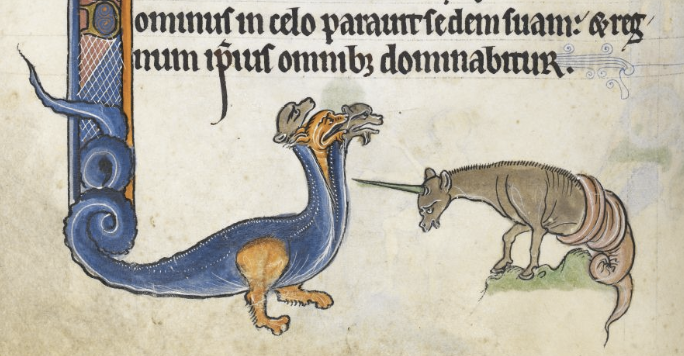
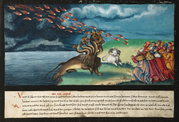
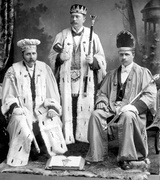 Decoding Secret Societies: What Are All Those Old Boys' Clubs Hiding?
Decoding Secret Societies: What Are All Those Old Boys' Clubs Hiding?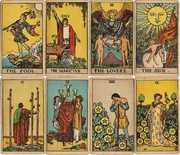
 Storybook Apocalypse: Beasts, Comets, and Other Signs of the End Times
Storybook Apocalypse: Beasts, Comets, and Other Signs of the End Times Decoding Secret Societies: What Are All Those Old Boys' Clubs Hiding?
Decoding Secret Societies: What Are All Those Old Boys' Clubs Hiding? Tarot Mythology: The Surprising Origins of the World's Most Misunderstood Cards
Tarot Mythology: The Surprising Origins of the World's Most Misunderstood Cards DrawingsThere’s an immediacy to drawings that is not always present in paintings on…
DrawingsThere’s an immediacy to drawings that is not always present in paintings on… BiblesAs the most widely read book in Western civilization, the Bible offers a va…
BiblesAs the most widely read book in Western civilization, the Bible offers a va… BooksThere's a richness to antique books that transcends their status as one of …
BooksThere's a richness to antique books that transcends their status as one of … Mari Tepper: Laying it on the Line
Mari Tepper: Laying it on the Line Nice Ice: Valerie Hammond on the Genteel Charm of Vintage Canadian Costume Jewelry
Nice Ice: Valerie Hammond on the Genteel Charm of Vintage Canadian Costume Jewelry How Jim Heimann Got Crazy for California Architecture
How Jim Heimann Got Crazy for California Architecture Modernist Man: Jock Peters May Be the Most Influential Architect You've Never Heard Of
Modernist Man: Jock Peters May Be the Most Influential Architect You've Never Heard Of Meet Cute: Were Kokeshi Dolls the Models for Hello Kitty, Pokemon, and Be@rbrick?
Meet Cute: Were Kokeshi Dolls the Models for Hello Kitty, Pokemon, and Be@rbrick? When the King of Comedy Posters Set His Surreal Sights on the World of Rock 'n' Roll
When the King of Comedy Posters Set His Surreal Sights on the World of Rock 'n' Roll How One Artist Makes New Art From Old Coloring Books and Found Photos
How One Artist Makes New Art From Old Coloring Books and Found Photos Say Cheese! How Bad Photography Has Changed Our Definition of Good Pictures
Say Cheese! How Bad Photography Has Changed Our Definition of Good Pictures Middle Earthenware: One Family's Quest to Reclaim Its Place in British Pottery History
Middle Earthenware: One Family's Quest to Reclaim Its Place in British Pottery History Fancy Fowl: How an Evil Sea Captain and a Beloved Queen Made the World Crave KFC
Fancy Fowl: How an Evil Sea Captain and a Beloved Queen Made the World Crave KFC
Fascinating article. Thank you!
Yes, what a fascinating article.
But I’m a little surprised that this article, in all its conjecture about why and what is the meaning of Marginalia, did not suggest this: what if Marginalia was simply doodling? an artistic outlet to pass the time away… with all of its nonsensical images and idle irreverent meanings? Has anyone seen someone else’s doodling? Its bizarre! funny, but just bizarre in the way that marginalia seems to be….
Matt- It’s highly unlikely that Marginalia would be idle doodling. The materials used to create these manuscripts were extraordinarily expensive, and the process was extremely time consuming.
Maybe they’re not doodling, exactly. I do illuminations myself, and it can get so tedious! Sometimes I just need to refocus, take a break, and work on something less serious. Maybe marginalia runs along those same lines – taking a break from the task at hand.
If you study Medieval memory techniques, the content and function of illuminations and marginalia becomes less opaque. Books were rare and expensive and designed to be memorised, particularly in monastic settings where memorising sacred texts was widespread. Memorisation involves the use of bizarre and vivid images that are placed into memory palaces. The imagery used in marginalia would be ideal for this purpose. In England, there were Puritan tracts that attacked these memory techniques because of the bawdy imagery that was used! The practice died out with the widespread availability of affordable books and the subsequent decline in the need for memorisation.
The picture captioned ‘A grotesque image of an ogre shooting an arrow into another creature’s rear from the Rutland Psalter’ in fact shows a couple of the strange races of men described by Pliny in his Natural History. A skiapod lies on his back shading himself from the sun (as they are wont to do), and a Blemmye (one of the men ‘whose heads do grow beneath their shoulders’) shoots at him.
I just checked out the British Library’s excellent site on the Rutland Psalter marginalia at http://britishlibrary.typepad.co.uk/digitisedmanuscripts/2013/05/marginali-yeah-the-fantastical-creatures-of-the-rutland-psalter.html and there are other borrowings from Pliny to be found there.
The scatology also needs contextualising like the elephants. In the early middle ages, bodily functions were not considered obscene (they returned to being so in the Renaissance, when secularism shifted swearing away from saints and iconography). Farting in particular was still considered acceptable as late as Johnson’s Dictionary, when other functions were ‘tastefully’ omitted. These images are rather like saying “monks are people too”, an understandable lament by a copist himself a monk, perhaps not even by his own choice (many younger sons having been parked in monasteries by their parents from a young age). In this sense some marginalia is likely doodling, tolerated as schoolboys doodling is tolerated (and sometimes wryly praised) in the margins of otherwise conscientious homework.
nice one
Very interesting article. Well written, and easy to follow.